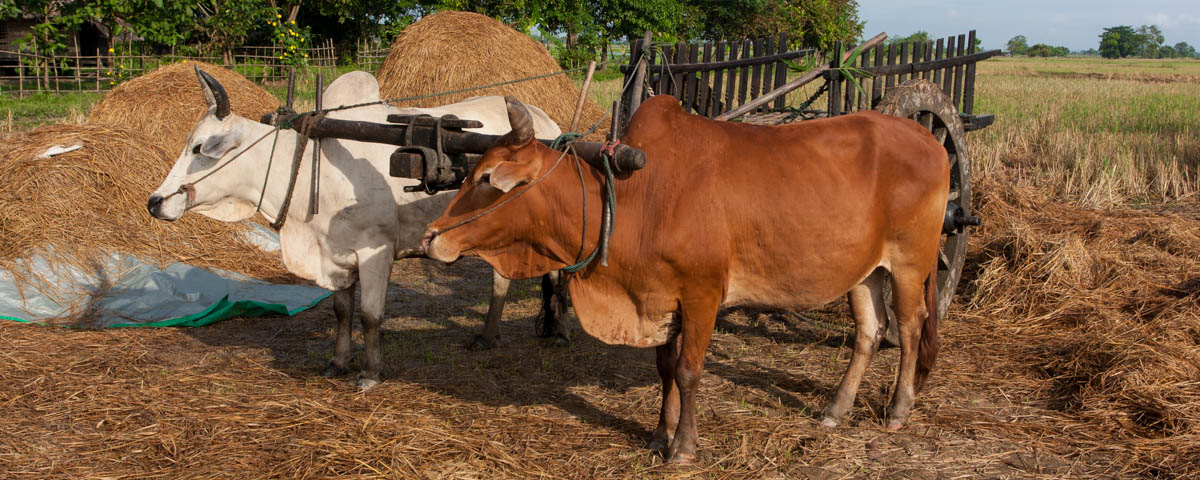Country and People
The country's official name is the Republic of the Union of Myanmar. The current population is estimated at 48.4 million inhabitants (2011). This corresponds to a population density of 70 people per km2. Myanmar is a union of seven states and seven divisions. In Myanmar live about 100 different tribes. Three quarters of the population lives in rural areas, the remaining quarter in cities like Yangon, Mandalay and Mawlamyaing.
Geography
Myanmar covers an area of 667,000 km2. In the west and northwest it borders on Bangladesh and India in the north and northeast on China and Laos and Thailand to the east. Central Myanmar is characterized by its central lowlands with Sittaung and Chindwin valleys and the central valley, surrounded by steep and rugged highlands. The highest mountain of the country is the Hkakabo Razi, 5.881m high. In the west of Myanmar there is the Rakhine Mountain range which extends to Manipur in the west to the coast of the Bay of Bengal in the south. The Bago Mountains separate the Ayarwaddy Valley from eastern Myanmar. The largest stream is the Ayarwaddy with a length of over 2,000 km. The river is navigable for about 1,500 km and thus it is an important transport route. The valley of the Ayarwaddy and its delta are the most fertile agricultural regions of Myanmar. The most of the exported rice comes from this region. Myanmar is surrounded by high mountain ranges which partly are impassable. The same applies to mountain ranges within Myanmar.
Climate
The climate is characterized by the south-east monsoon. The weather is divided into three seasons - summer, rainy season and cold season. The hottest months are March to May. The average temperature ranges between 30 and 35 °C. After the rainy season begins. The average temperatures are 25-30 °C. In October the rainfall diminishes, from November the cold season (20-25 °C) begins and lasts until February. The best time to visit Myanmar is the cold season, although it hardly rains during the rainy season in the regions around Bagan and Mandalay. The humidity is between 66-82% throughout the year.
Peoples and Languages
There are many linguistic groups in Myanmar. The official language is Myanmarian (Burmese). The majority of the population speaks Myanmarian, including ethnic minorities. Approximately 10% of the population speaks Thai. Also, English is understood.
Myanmarian is a tonal, tone length-dependent language. Burmese words are mostly monosyllabic, by different pronunciation in pitch and length of syllables produce different meanings. The sentence structure corresponds to the word order subject-object-verb. The Myanmarian is a member of the Tibeto-Burmese language family. The language uses the Burmese script, derived from the old Mon script, which in turn derived from the Brahmi script.
Religion
Myanmar is a Buddhist country. 87% of the population are Buddhist, 6% Christian, 4% Muslim and 3% Hindu. Theravada Buddhism is the predominant religion. It’s an integral part of Burmese culture. The culture of Myanmar knows many festivals and holidays, which find their expression in various pagoda festivals. Some of the most famous Buddhist monuments and statues are located in Myanmar, especially the Shwe Dagon Pagoda.
History
Prehistory: The area of present-day has been settled for 15,000 years. First artifacts were found in Nyaunggan and dated from the Bronze Age.
First Civilizations: The first recognizable civilization was the people of the Mon. The Mon immigrated by about 300 BC in the area around Thaton, and founded there their first kingdom Suvarnabhumi.
When the Khmer Empire from Angkor expanded its influence to the west, the Mon people who lived there were displaced and there was a second wave of immigration into southern Myanmar. The Mon founded the kingdoms of Thaton and Bago (Pegu) which lasted from the 6th to the 8th Century.
In the first Century AD, the Pyu migrated into northern Burma and founded several city-states such as Sri Ksetra, Binnaka and Halingyi. The main town, Ksetra, was the center of power from 96-656 AD. During this time, a trade route from China to India led through this area.
Ksetra was later replaced by Halingyi as its capital. However, the new capital was destroyed in the middle of the 9th Century and thus ending the Pyu period.
Kingdom of Bagan: The power vacuum was filled by the Bamar. They founded the kingdom of Bagan in 849 AD. The kingdom growed only slowly until the Mon Kingdom of Thaton in 1057 AD was defeated. This was the first time where all Burmese (Bamar) combined under one king (Anawratha). The Kingdom of Bagan existed until 1289 and was finally conquered by the advancing Mongols under Kublei Khan.
Kingdom of Awa: After the destruction of the kingdom of Bagan, Myanmar was divided once again. The Bamar established the Kingdom of Awa in 1364. The culture of Bagan was revived and literature flourished. However, the kingdom was militarily weak and was overrun by the Shan in 1527. The survivors of the Kingdom of Awa (Inwa) established the Kingdom of Taungoo in 1531. King Tabinshwethi unified the most Bamar behind.
Kingdom of Taungoo: The Kingdom of Taungoo lasted from 1486 to 1599. During this time the Kings tried to conquer more territories, but had not enough revenue to keep these areas as well. Under the influence of the French Bago rebelled against Awa and weakened the kingdom until it finally collapsed in 1752.
Konbaung Dynasty: It did not take long and a new dynasty arose, the Konbaung Dynasty (1759-1824). Their capital was Yangon. Under King Alaungpaya the kingdom was enlarged. King Alaungpaya fell in the attack against Ayutthaya. His son Hsinbyushin finally conquered it in 1766. The Konbaung empire eventually included parts of Siam, South China, Manipur, Arakan and Assam and parts of India. The conquest of Assam (India) made the British aware of Myanmar.
First Anglo-Burmese War: In response to the recent conquests of the Kobaung dynasty the British attacked along with the Siamese Myanmar. The First Anglo-Burmese War (1824-1826) ended with a British victory and resulted in the Treaty of Yandaboo. Myanmar lost Assam, Manipur, Arakan and Tenasserim.
Second Anglo-Burmese War: In the middle of the 19th Century, the British began to be interested in the natural resources of Myanmar and also wanted to secure their supply route to Singapore. During the Second Anglo-Burmese War the British annexed the area around Bago in 1852 and renamed it in Lower Burma. This led to unrest in Myanmar King Mindon came to power. He founded the new capital of Mandalay and tried to modernize the Burmese state and the economy in order to resist the attacks of the British in future. Although this was not enough to stop the British, but the son of King Mindon, Thibaw, allied with the French, and declared the war to the British in 1885.
Third Anglo-Burmese War: The British won also the third war and turned Burma into a province of British India with capital Rangoon. Although Burma generated a lot of wealth under the British rule, the proceeds went only to the British and the Indian government. This led to growing protests and rebellions.
The British responded to this unrest with heavy-handed violence, a strategy that has been adopted by subsequent military dictatorships. In 1938 killed the British police during student protests 17 people. During protests by monks in Mandalay, the police shot into the crowd.
During the second world war, the Burmese nationalists allied with the Japanese, and Burma gained its independence from Britain in 1948.






